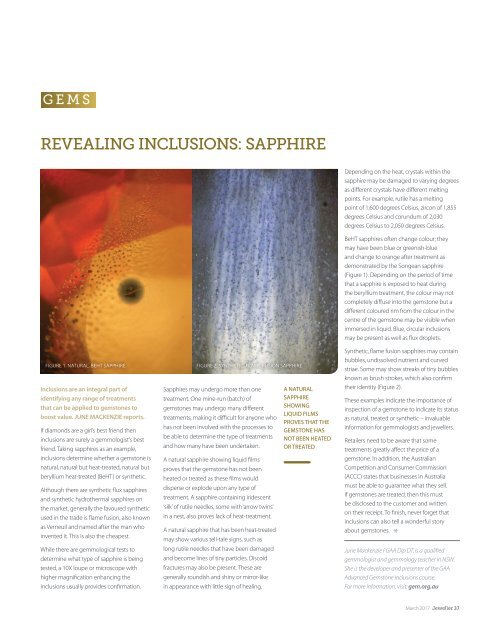Jeweller - March Issue 2017
Create successful ePaper yourself
Turn your PDF publications into a flip-book with our unique Google optimized e-Paper software.
GEMS<br />
REVEALING INCLUSIONS: SAPPHIRE<br />
FIGURE 1. NATURAL, BEHT SAPPHIRE<br />
Inclusions are an integral part of<br />
identifying any range of treatments<br />
that can be applied to gemstones to<br />
boost value. JUNE MACKENZIE reports.<br />
If diamonds are a girl’s best friend then<br />
inclusions are surely a gemmologist’s best<br />
friend. Taking sapphires as an example,<br />
inclusions determine whether a gemstone is<br />
natural, natural but heat-treated, natural but<br />
beryllium heat-treated (BeHT) or synthetic.<br />
Although there are synthetic flux sapphires<br />
and synthetic hydrothermal sapphires on<br />
the market, generally the favoured synthetic<br />
used in the trade is flame fusion, also known<br />
as Verneuil and named after the man who<br />
invented it. This is also the cheapest.<br />
While there are gemmological tests to<br />
determine what type of sapphire is being<br />
tested, a 10X loupe or microscope with<br />
higher magnification enhancing the<br />
inclusions usually provides confirmation.<br />
FIGURE 2. SYNTHETIC, FLAME FUSION SAPPHIRE<br />
Sapphires may undergo more than one<br />
treatment. One mine-run (batch) of<br />
gemstones may undergo many different<br />
treatments, making it difficult for anyone who<br />
has not been involved with the processes to<br />
be able to determine the type of treatments<br />
and how many have been undertaken.<br />
A natural sapphire showing liquid films<br />
proves that the gemstone has not been<br />
heated or treated as these films would<br />
disperse or explode upon any type of<br />
treatment. A sapphire containing iridescent<br />
‘silk’ of rutile needles, some with ‘arrow twins’<br />
in a nest, also proves lack of heat-treatment.<br />
A natural sapphire that has been heat-treated<br />
may show various tell-tale signs, such as<br />
long rutile needles that have been damaged<br />
and become lines of tiny particles. Discoid<br />
fractures may also be present. These are<br />
generally roundish and shiny or mirror-like<br />
in appearance with little sign of healing.<br />
A NATURAL<br />
SAPPHIRE<br />
SHOWING<br />
LIQUID FILMS<br />
PROVES THAT THE<br />
GEMSTONE HAS<br />
NOT BEEN HEATED<br />
OR TREATED<br />
Depending on the heat, crystals within the<br />
sapphire may be damaged to varying degrees<br />
as different crystals have different melting<br />
points. For example, rutile has a melting<br />
point of 1,600 degrees Celsius, zircon of 1,855<br />
degrees Celsius and corundum of 2,030<br />
degrees Celsius to 2,050 degrees Celsius.<br />
BeHT sapphires often change colour; they<br />
may have been blue or greenish-blue<br />
and change to orange after treatment as<br />
demonstrated by the Songean sapphire<br />
(Figure 1). Depending on the period of time<br />
that a sapphire is exposed to heat during<br />
the beryllium treatment, the colour may not<br />
completely diffuse into the gemstone but a<br />
different coloured rim from the colour in the<br />
centre of the gemstone may be visible when<br />
immersed in liquid. Blue, circular inclusions<br />
may be present as well as flux droplets.<br />
Synthetic, flame fusion sapphires may contain<br />
bubbles, undissolved nutrient and curved<br />
striae. Some may show streaks of tiny bubbles<br />
known as brush strokes, which also confirm<br />
their identity (Figure 2).<br />
These examples indicate the importance of<br />
inspection of a gemstone to indicate its status<br />
as natural, treated or synthetic – invaluable<br />
information for gemmologists and jewellers.<br />
Retailers need to be aware that some<br />
treatments greatly affect the price of a<br />
gemstone. In addition, the Australian<br />
Competition and Consumer Commission<br />
(ACCC) states that businesses in Australia<br />
must be able to guarantee what they sell.<br />
If gemstones are treated, then this must<br />
be disclosed to the customer and written<br />
on their receipt. To finish, never forget that<br />
inclusions can also tell a wonderful story<br />
about gemstones. i<br />
June Mackenzie FGAA Dip DT, is a qualified<br />
gemmologist and gemmology teacher in NSW.<br />
She is the developer and presenter of the GAA<br />
Advanced Gemstone Inclusions course.<br />
For more information, visit: gem.org.au<br />
<strong>March</strong> <strong>2017</strong> <strong>Jeweller</strong> 37


















